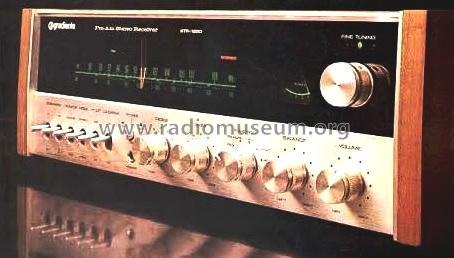Fm-Am Stereo Receiver STR-1250
Gradiente Eletrônica S.A.; São Paulo
- Country
- Brazil
- Manufacturer / Brand
- Gradiente Eletrônica S.A.; São Paulo
- Year
- 1974 ?
- Category
- Broadcast Receiver - or past WW2 Tuner
- Radiomuseum.org ID
- 331388
Click on the schematic thumbnail to request the schematic as a free document.
- Number of Transistors
- Semiconductors present.
- Semiconductors
- Main principle
- Superheterodyne (common)
- Wave bands
- Broadcast (BC) and FM or UHF.
- Details
- Hi-Fi equipment
- Power type and voltage
- Alternating Current supply (AC) / 110; 220 Volt
- Loudspeaker
- - This model requires external speaker(s).
- Power out
- 64 W (undistorted)
- Material
- Wooden case
- from Radiomuseum.org
- Model: Fm-Am Stereo Receiver STR-1250 - Gradiente Eletrônica S.A.; São
- Shape
- Book-shelf unit.
- Dimensions (WHD)
- 430 x 140 x 350 mm / 16.9 x 5.5 x 13.8 inch
- Notes
-
Inputs: Phono (moving magnet), Tape, Aux and Mic
Output power: 2 x 32 W RMS into 8 Ω, 2 x 40 W RMS into 4 Ω
AC outlets: 2 (110 - 220 V)There are different versions of this receiver, namely with the following prints on the back:
- IGB - Amazonia S/A., Av. Assai
Industria Brasileira, C.G.C. 04.209.912/0001-29
Produzida na Zona Francia de Manaus
- Made in Brazil
The schematic indicates:
- Gradiente - Receiver STR 1250 C / Monobloco Alps
- IGB - Amazonia S/A., Av. Assai
- Net weight (2.2 lb = 1 kg)
- 10.2 kg / 22 lb 7.5 oz (22.467 lb)
- Author
- Model page created by Antonio Rabitti. See "Data change" for further contributors.
- Other Models
-
Here you find 34 models, 34 with images and 5 with schematics for wireless sets etc. In French: TSF for Télégraphie sans fil.
All listed radios etc. from Gradiente Eletrônica S.A.; São Paulo
Forum contributions about this model: Gradiente Eletrônica: Fm-Am Stereo Receiver STR-1250
Threads: 1 | Posts: 1
With reference to the product Gradiente model STR-1250 it was added in the text by the administrators that this model probably has Japanese parts. This is not correct. Gradiente produced this model (and others that I'll upload) entirely.
What happens is that our hi-fi audio market followed Japanese standards mainly with regard to connections.
Philips unsuccessfully tried to impose the DIN standard, but had to surrender to the market imposition created by other local hi-fi audio manufacturers (Gradiente, Polyvox, Quasar, CCE, Spectro, Gavox, Greynolds, etc.) who adopted the Japanese standard for connections .
Antonio Rabitti
Mike Edwards † 25.10.21, 08.Aug.21


